American Bittern - Carlton Marshes © Andrew Easton A RED-RUMPED SWALLOW flew north at Corton on the 28th. Two singing MARSH WARBLERS were found in Lowestoft on the same day, with on still present on the 29th. A GREAT WHITE EGRET was at Oulton Marshes on the 27th. OSPREYS flew over Carlton Marshes on the 13th, 21st and 25th. A flock of seven COMMON CRANES flew over St Olaves on the 19th and continued on along the Waveney Valley over Carlton Marshes, with five later being seen over Reydon. |
| If you wish to
receive local bird news messages you can now
follow @LowestoftLizard on Twitter. Follow @LowestoftLizard UPDATED: 23:00 29th May |
SUFFOLK WILDLIFE TRUST SUFFOLK BROADS APPEAL |
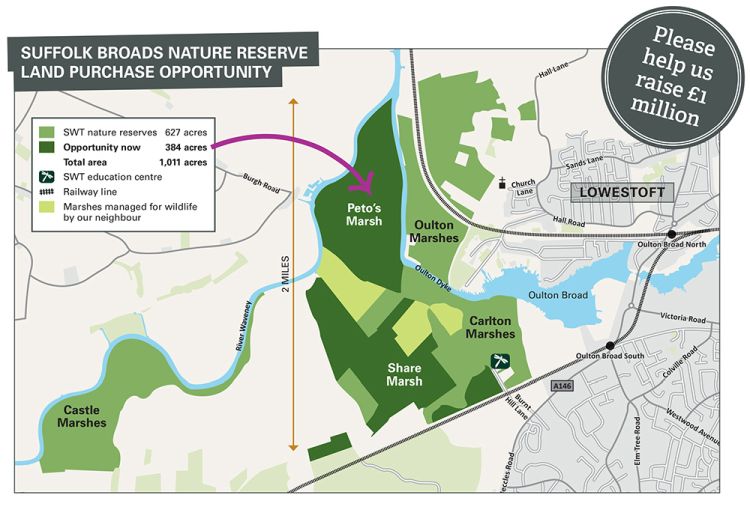 |
|
Regular readers will have noticed sightings from Carlton and Oulton Marshes appearing increasingly frequently over the last four years. This increase has been brought about by the creation of scrapes in small, formerly just grass, fields on both of these reserves by the SWT Broads Warden Matt Gooch and his dedicated team of volunteers. -++++++++++++++++++++++++++++++++++++++++++++++++++++++++++++++++++++++++++-++-++, Waders and wildfowl that formerly just flew over, or at best maybe stopped off to feed in a ditch for a few hours, now often stay for days in these newly created havens. Shoveler, Lapwing and Redshank are now successfully rearing young around these scrape fields. For years we in Lowestoft we have dreamed that Peto's Marsh might one day be brought back to life as a nature reserve and now this dream is within sight, with the added bonus of Share Marsh also becoming available to purchase at the same time. The plans are to create a new reedbed, which will be the largest in the Broads, and new scrapes and dykes. All that is needed now are the funds to buy the land and begin the restoration of this corner of the Broads. Clicking on the map above will open a new window to take you to the Suffolk Wildlife Trusts Suffolk Broads Appeal pages, with more details of their vision for the area and their donation page. Please donate what you can to help make views like that below become regular sights in a premier nature reserve on the outskirts of Lowestoft. |
 |
| Carlton Marshes - 11th May 2016 Two Spoonbills feed on the new scrape while two belligerent Little Egrets argue over territory in the background. |
GREAT CRESTED GREBE Podiceps cristatus
Corton - 5th (1 on the sea).
SHAG Phalacrocorax aristotelis
Lake Lothing - 12th & 13th (1), 16th (1).
FULMAR Fulmarus glacialis
Gunton Warren - 2nd (1 S).
Ness Point - 7th (1 N), 10th (1 N).
CEFAS - 21st (1), 30th (1).
AMERICAN BITTERN Botaurus lentignosus
The American Bittern showed for a prolonged period on the evening of the 1st, but on the 2nd it wasn't seen after being seen in flight at 16:30, but then at 19:30 its trisyllabic mechanical gulping/pumping song started up from the reeds and was still going at sunset at 20:20.
On the 3rd it was seen in flight a few times over Share Marsh but was again "singing" during the afternoon and evening. On the 4th to 6th its "singing" became less frequent and most mostly confined to the evening and then it was best heard from the river bank. On the evening of the 6th it was visible whilst "singing".
It was "singing" again on the evening of the 8th. It was seen in flight on the morning of the 9th and appeared to head off in the Barnby Marshes direction, but in the evening it was back at Share Marsh, being seen in flight several times and "singing" again.
Over the 10th to 13th it remained generally as elusive as ever, being seen mostly in flight on a few occasion each day. The last known sighting was on the afternoon of the 16th, though given how elusive it has been, and with fewer people looking it could still be present.
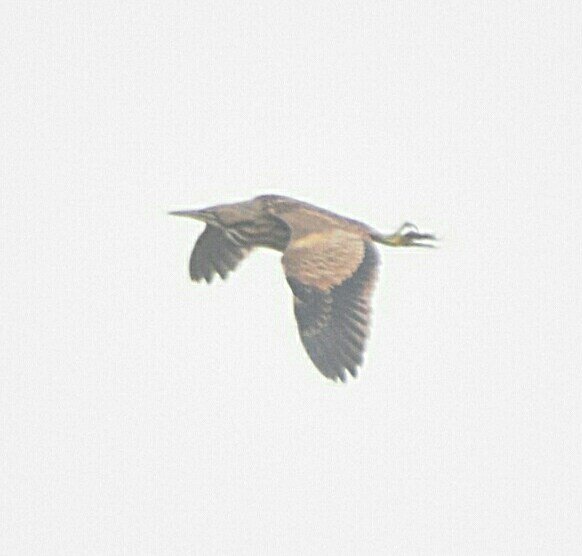 |
 |
| American
Bittern
-
Carlton
Marshes © Rene Baptiste |
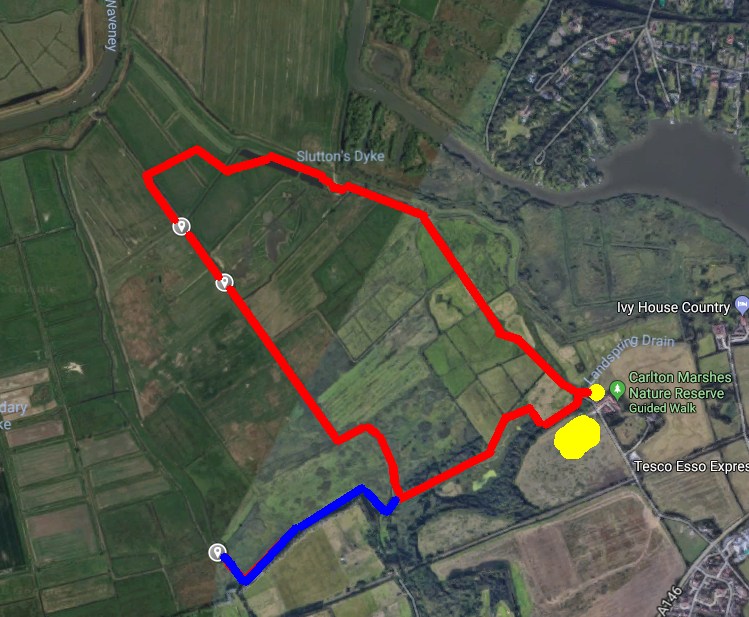 |
| On most days it has favoured the same
area of Share Marsh to the south and west of the
grey location markers around grid reference TM496925
on the map above. This is reached by a circular path
that although muddy in places is now starting to dry
out. It is also sometimes seen in the fields in the southern corner of the march near the end of the long row of obvious tall poplar trees, this section is reached by the path marked in blue that has VERY wet and boggy sections. Parking areas are marked in yellow. |
 |
| American
(right)
& Eurasian
Bittern
-
Carlton
Marshes © Andrew
Easton |
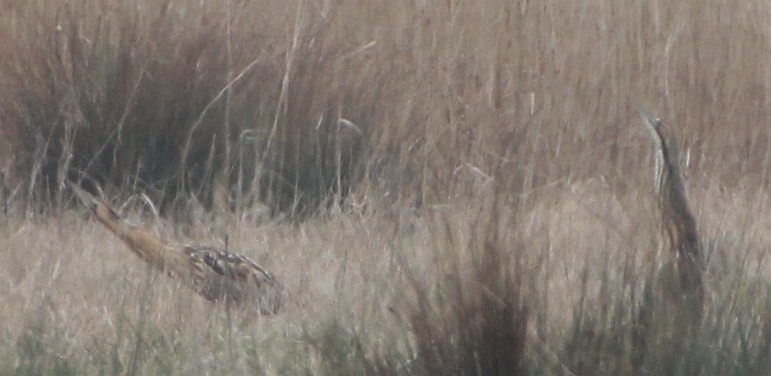 |
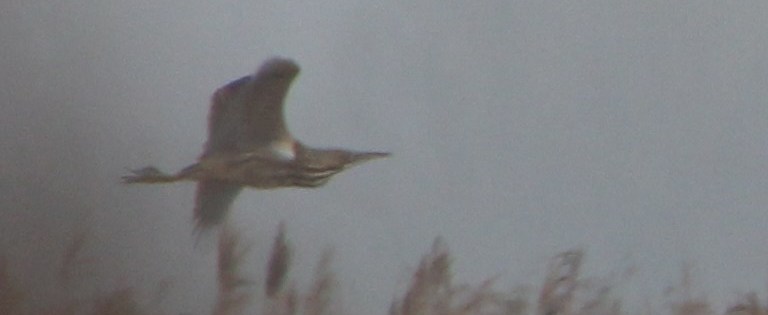 |
| American
Bittern
-
Carlton
Marshes © Andrew
Easton Showing the prominent white feathering on the breast side exposed during display. |
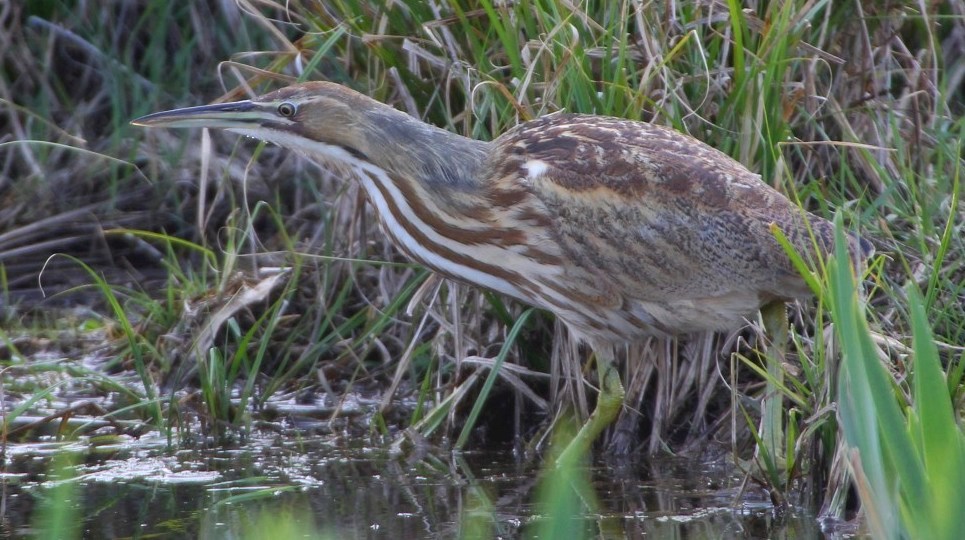 |
EURASIAN BITTERN Botaurus stellaris
Carlton Marshes - 5th (1), 8th (1), 9th (1).
GREAT WHITE EGRET Ardea alba
Oulton Marshes - 27th (1).
SPOONBILL Platalea leucorodia
One was feeding on the mudflats along Breydon South Wall on the 13th, with two there on the 19th.
BARNACLE GOOSE Branta leucopsis
Carlton Marshes - 2nd (2), 3rd (2), 6th (2), 7th (2), 8th (2), 9th (2), 12th (2), 19th (2).
TEAL Anas crecca
Carlton Marshes - 19th (1),
GARGANEY Anas querquedula
Carlton Marshes - 12th (drake).
TUFTED DUCK Aythya fuligula
Carlton Marshes - 2nd (4), 3rd (4), 7th (2), 8th (4), 9th (2), 12th (2), 19th (4).
COMMON SCOTER Melanitta nigra
Pakefield - 5th (42 on the sea)
OSPREY Pandion haliaetus
Single birds flew over Carlton Marshes on the 13th, 21st and 25th.
RED KITE Milvus milvus
Carlton Marshes - 5th (1), 9th (1), 19th (1), 21st.
Beverley Close - 7th (1).
Belton - 7th (1).
Barnby - 17th (1).
North Cove - 19th (1).
Ellough - 19th (1).
BUZZARD Buteo buteo
Oulton Marshes - 4th (1).
Carlton Marshes - 5th (19), 12th (9).
HOBBY Falco subbuteo
Kirkley Cemetery - 1st (1).
Corton new sewage works - 1st (1).
CEFAS (Pakefield) - 2nd (1).
Pontins, Pakefield - 3rd (1).
Oulton Marshes - 4th (1).
Carlton Marshes - 5th (3+), 7th (2), 9th (1), 12th (2). 26th (2).
Castle Marshes, North Cove - 1st (2), 3rd (4), 4th (4), 5th (2), 10th (2).
Kessingland Levels - 13th (1).
WATER RAIL Rallus aquaticus
Carlton Marshes - 5th (1).
COMMON CRANE Grus grus
On the 4th two flew over Morrisons at Pakefield and continued on over Carlton Marshes.
On the 19th seven flew over St. Olaves and then Carlton Marshes, they flew back over Carlton Marshes in the afternoon.
AVOCET Recurvirosta avosetta
Carlton Marshes - 2nd (10), 3rd (6), 6th (8), 7th (8), 8th (8), 12th (9).
On the 18th a brood of four were on the scrape at Carlton Marshes, the first breeding attempt by the species at this site.
DUNLIN Calidris alpina
Carlton Marshes - 12th (1).
RUFF Philomachus pugnax
Carlton Marshes - 7th (3), 8th (3), 9th (1).
GREENSHANK Tringa nebularia
Corton - 1st (1).
BLACK-TAILED GODWIT Limosa limosa
Carlton Marshes - 7th (6), 8th (21).
WHIMBREL Numenius phaeopeus
Castle Marshes, North Cove - 1st (37), 3rd (48), 4th (20+), 5th (20+), 9th (2), 10th (2).
Kessingland - 19th (2 N), 25th (1).
COMMON SANDPIPER Actitis hypoleucos
Carlton Marshes - 2nd (1), 3rd (1), 7th (1), 12th (1), 26th (1), 27th (1).
Pakefield - 5th (1 N).
Castle Marshes, North Cove - 10th (1).
Leathes Ham - 19th (1).
SANDWICH TERN Sterna sandvichensis
Kessingland - 6th (5 S).
LITTLE TERN Sternula albifrons
Kessingland - 5th (4).
 |
BARN OWL Tyto alba
Carlton Marshes - 2nd (3+), 3rd (2), 19th (1).
SWIFT Apus apus
Gunton Warren - 2nd (1).
Waveney Hill - 2nd (5).
Corton - 2nd (1).
Carlton Marshes - 6th (3), 7th (5), 9th (6), 12th (12), 13th (c. 25), 19th (12).
Castle Marshes, North Cove - 10th (10+).
CUCKOO Cuculus canorus
Castle Marshes, North Cove - 1st (2), 10th (1).
Carlton Marshes - 2nd (2), 3rd (1), 4th (4), 9th (2), 12th (3), 13th (2), 26th (3).
Kessingland sewage works - 3rd (1).
Oulton Marshes - 4th (1).
Pakefield - 5th (1).
St. Olaves - 5th (1).
Kessingland Sluice - 13th (3).
RED-RUMPED SWALLOW Cecropis daurica
One flew north at Corton old sewage works on the morning of the 28th.
SWALLOW Hirundo rustica
Oulton Marshes - 2nd (c. 50).
Ness Point - 10th (2 N).
HOUSE MARTIN Delichon urbica
Carlton Marshes - 13th (c. 30), 27th (3).
BOHEMIAN WAXWING Bombycilla garrulus
One was seen in a north Lowestoft garden on the 1st.
YELLOW WAGTAIL Motacilla flava flavissima
Corton Cliffs - 1st (6a).
Carlton Marshes - 2nd (4), 3rd (1), 6th (1), 7th (2), 9th (2), 18th (2).
Pakefield - 4th (2).
GREY WAGTAIL Motacilla cinerea
Corton old sewage works - 12th (1).
TREE PIPIT Anthus trivialis
Gunton Warren - 26th (1, possibly two, over).
Lowestoft North Denes - 28th (2).
Gunton disused railtrack - 28th (1 over).
COMMON REDSTART Phoenicurus phoenicurus
Lowestoft North Denes - 2nd (1).
Corton disused railtrack - 2nd (1).
Marsh Lane, Kessingland - 3rd (1).
WHINCHAT Saxicola rubetra
Corton new sewage works - 1st (2).
Kessingland Sluice - 3rd (2).
WHEATEAR Oenanthe oenanthe
Corton new sewage works - 1st (4).
Lowestoft North Denes - 1st (3).
Riverside Road, Lowestoft - 1st (5).
Barnby Marshes - 1st (1).
Gunton Warren - 2nd (4).
Carlton Marshes - 3rd (2), 9th (1).
Kessingland Sluice - 3rd (13), 19th (1).
Pakefield Church - 3rd (3).
Pakefield Beach - 3rd (1).
Gunton - 6th (1).
Corton old sewage works - 28th (1).
RING OUZEL Turdus torquatus
Corton new sewage works - 1st (2).
Gunton - 1st (1).
GRASSHOPPER WARBLER Locustella naevia
Carlton Marshes - 2nd (4+), 3rd (2), 4th (2), 8th (2), 9th (1), 19th (1), 26th (3), 28th (2).
SEDGE WARBLER Acrocephalus schoenobaenus
Corton new sewage works - 2nd (1).
Oulton Marshes - 4th (11).
Carlton Marshes - 9th (14), 19th (14).
REED WARBLER Acrocephalus scirpaceus
Oulton Marshes - 4th (1).
Carlton Marshes - 9th (13), 19th (27).
MARSH WARBLER Acrocephalus palustris
On the 28th one was found singing along Gunton disused railtrack and another was close by adjacent to Links Road car park on Lowestoft North Denes. The one on the Denes was still present and singing on the 29th.
BLACKCAP Sylvia atricapilla
Maltster's Score - 2nd (3).
Oulton Marshes - 4th (4).
St. Olaves - 5th (2).
GARDEN WARBLER Sylvia borin
Corton disused railtrack - 1st (1).
Oulton Marshes - 4th (3).
Angles Way, Blundeston - 8th (3).
LESSER WHITETHROAT Sylvia curruca
Denes Oval - 2nd (1).
Pakefield - 5th (1).
Corton new sewage works - 6th (1), 7th (1).
WILLOW WARBLER Phylloscopus trochilus
Corton disused railtrack - 1st (2), 2nd (5).
Maltster's Score - 2ndt (4).
Lowestoft North Denes - 2nd (2).
St. Peters Church, Kirkley - 3rd (2).
Gunton Warren - 5th (1).
Angles Way, Blundeston - 8th (1).
FIRECREST Regulus ignicapilla
Maltster's Score - 4th (1).
Gunton disused railtrack - 6th (1).
'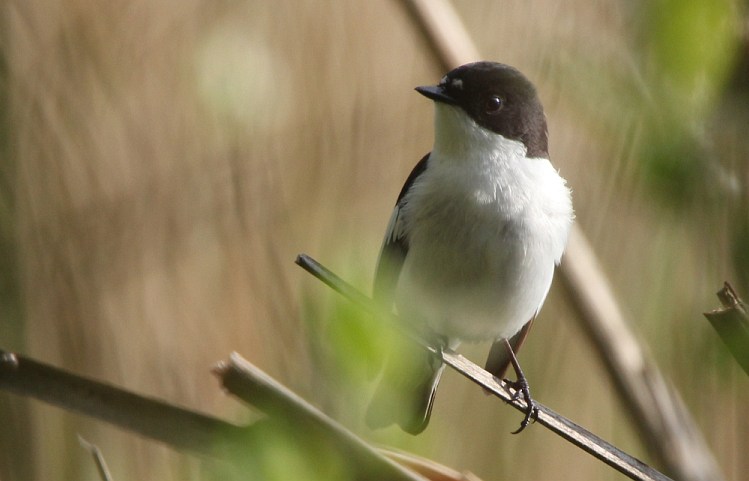 |
| Pied Flycatcher - Leathes Ham (above) Lowestoft North Denes (below) © Andrew Easton |
 |
PIED FLYCATCHER Ficedula hypoleucos
Corton disused railtrack - 1st (2).
Corton new sewage works - 1st (1).
Lowestoft North Denes - 2nd (1).
Leathes Ham - 3rd (1).
Lound Lakes - 3rd (1).
Fisher Row, Oulton Marshes - 4th (1).
Gunton disused railtrack - 28th (1).
SISKIN Carduelis spinus
Maltster's Score - 4th (singing male).
BRAMBLING Fringilla montifringilla
Corton disused railtrack - 1st (1).
CROSSBILL Loxia curvirostra
Four flew north over Lowestoft North Denes on the 29th.
 |


